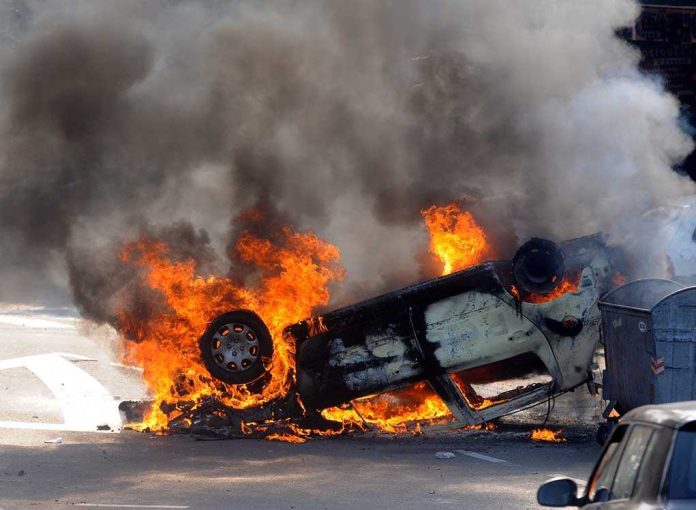
When a Bronx street erupted in a searing fireball, seven New York City firefighters faced a scene they’ll never forget—and neither will anyone who witnesses the aftermath of a car explosion in the nation’s busiest city.
Story Snapshot
- A trash fire in the Bronx triggered a devastating car explosion, sending flames skyward
- Seven firefighters were injured battling the blaze, underscoring the ever-present dangers they face
- The incident highlights the unpredictable hazards of urban fires and vehicle-related emergencies
- Public concern rises over fire safety as communities question how quickly small fires can escalate
Chain Reaction: How a Simple Trash Fire Became a Bronx Inferno
New York City’s emergency responders know better than anyone how chaos can ignite from the most mundane sources. On an otherwise unremarkable day in the Bronx, a trash fire—something most city dwellers have seen smolder in alleyways—suddenly transformed into a full-fledged catastrophe. Flames leaped from discarded debris to parked vehicles, an all-too-possible scenario in densely packed neighborhoods. Within seconds, the ordinary became explosive as one car, then several, were engulfed. The resulting fireball was visible for blocks, a terrifying spectacle that no passerby could ignore.
As emergency sirens wailed and crowds gathered at a safe distance, the city’s bravest rushed in. The scene was chaotic—heat radiated off metal, windows shattered, and fuel-fed flames surged with uncontrolled ferocity. For the seasoned professionals of the New York City Fire Department, training met reality in a battle against time and physics. The volatility of burning vehicles, with their pressurized fuel tanks and synthetic interiors, posed a lethal threat not only to firefighters but to anyone nearby. The split-second decisions made in those moments determined not just the fate of the vehicles but the safety of the entire block.
The Human Cost: Seven Firefighters Injured on Duty
Emergency response is never routine, and this incident proved that yet again. Seven firefighters sustained injuries in the explosion and subsequent blaze. Their injuries, though non-fatal, serve as a sobering reminder of the risks first responders willingly take. Each injury is a testament to the unpredictable nature of urban firefighting, where a call about a minor fire can escalate into a life-threatening inferno in moments. The city’s response was swift, with medical teams on standby and support systems activated for the injured. The physical scars may heal, but the memory of this explosion will linger in the minds of those who witnessed it—both as bystanders and as heroes on the front line.
Public reaction was immediate and intense. Social media lit up with firsthand videos, photos, and commentary. Many expressed gratitude for the firefighters’ bravery, while others questioned how a trash fire could spiral so quickly out of control. The incident has sparked renewed conversation about fire safety, prevention, and the importance of rapid, coordinated emergency response in urban environments. For residents, the explosion shattered any illusion that fires are rare or easily contained in a city of millions.
Urban Realities: Why Vehicle Fires Are Citywide Ticking Time Bombs
Vehicle fires in urban areas present unique challenges. Cars are ubiquitous, and their proximity to homes, businesses, and each other creates a perfect storm for chain-reaction disasters. Modern vehicles contain plastics, composite materials, and fuel systems that burn hot and fast, often releasing toxic fumes. A single spark in a crowded street can therefore escalate to a major emergency before first responders even arrive. In the Bronx explosion, the fire’s rapid spread demonstrated how quickly things can deteriorate in a landscape filled with potential fuel.
For city planners and emergency managers, incidents like this demand ongoing vigilance. Regulations on parking, waste disposal, and fire hydrant accessibility exist for a reason—yet enforcement and public awareness often lag behind necessity. The Bronx fireball has reignited debates about how cities can better protect residents and first responders from these all-too-frequent threats. Forward-thinking solutions might include stricter vehicle inspection standards, enhanced fire detection systems, and public education campaigns centered on fire prevention in high-density neighborhoods.
Aftermath and Open Questions: Can the City Prevent the Next Fireball?
As the smoke clears and the injured recover, New Yorkers are left with pressing questions. Could this explosion have been prevented with faster reporting or stricter fire code enforcement? Are current emergency response protocols sufficient for the realities of modern urban life, where risk is everywhere and time is always short? City officials face mounting pressure to review safety measures, while residents wonder what more they can do to protect themselves and their communities. The Bronx fireball stands as both a warning and a rallying point—a vivid demonstration that in New York, even the smallest spark can have citywide consequences.
For the seven firefighters who rushed toward the flames, the risk was never theoretical. Their bravery is both celebrated and scrutinized, as the city debates how to make sure the next call doesn’t end in tragedy. As memories of the explosion fade, the questions it raised about urban safety, emergency preparedness, and the unpredictable power of fire remain unresolved—demanding answers for a city that can never afford to let its guard down.










